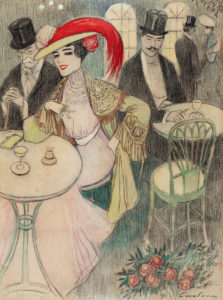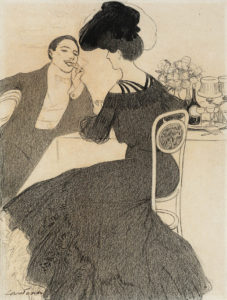Joan Cardona: the splendor of Belle Epoque
At the dawn of the 20th century, a generation of artists gathered around the “Els 4 Gats” tavern gave birth to one of the most splendid stages of Catalan art. The emblematic venue promoted by Ramón Casas, Santiago Rusiñol and Miguel Utrillo became the meeting point of Barcelona’s bohemia, where the most prominent artists, writers and musicians of the moment, were imbued with a new cultural spirit that, from Paris end of the century would settle forever in Barcelona.
Among those young regulars to “Els 4 Gats” was the Barcelona artist Joan Cardona, who a few years later would be recognized as one of the most prestigious artists of the Paris of the Belle Epoque. The success that the artist managed to conquer in life is largely due to the multitude of drawings in which he illustrated the atmosphere of modernity that at that time radiated everywhere in the city. In this sense, the pair of works that will be available for auction on the 14th next, represent a magnificent testimony of the style that Cardona cultivated from his arrival in Paris in 1900, until his return to Barcelona after the outbreak of the first war. world in 1914
After a period of training in Barcelona, the desire to experience the artistic life of a city in Paris in full cultural turmoil, led Cardona, as well as so many of his colleagues, to move their residence to the French capital. Installed in a small house located in the Montmartre neighborhood, he was able to fully immerse himself in Art Nouveau that at the end of the century broke out as a reflection of the new feeling of a society, which, hoping for progress, began to believe in the possibility of a more comfortable and relaxed life. It was then, when he began a passionate activity making drawings of nature in which he captured scenes of Parisian daily life and its characters. Cardona, would thus begin his triumphal rise as one of the essential illustrators in most of the artistic magazines of the time such as Gil Blas , L’Assiete Auburre , Le Frou-frou , Le rire , or Sans-Gêne . After his participation in the second Salon d’Automne, his success will be reaffirmed with the acquisition by the French state of his work “Avant la fete” for the Musée du Luxembourg, becoming one of the first Spanish artists together with Sorolla, Benlliure, Beruete, Zuloaga, Clarà and Rusiñol to be part of this collection.
In drawings like these, Cardona manages to capture the spirit that prevailed especially at that time, among the bourgeoisie and the aristocracy of the capital par excellence of the Belle Epoque. The works from this period constitute a magnificent visual chronicle of Parisian high society which, dominated by an optimistic and carefree attitude, enjoyed the pleasures that the city offered. In this context, Cardona will pay special attention to women, who will become, as in the case at hand, the true protagonists of his production. Whether strolling the streets, enjoying an opera or smoking and drinking in the city’s glamorous cafes, the artist portrays a prototype of an elegant and sophisticated woman who, in her attitudes, exudes a new air of modernity. The scope he achieved with his illustrations of sharp lines, sinuous lines and exquisite descriptive capacity was such that he gave his name to the so-called “cardona type” style.
After his death, the fame and international renown that accompanied him in life was diluted until he fell into oblivion. In a time of frenzied artistic activity where names that have reached the Olympus of art history accumulated, Cardona developed his work on the fringes of the revolution brought about by the avant-garde. The price he paid to stay true to his style shows us how history and the relentless passage of time are capable of dulling the brilliance of an artist who, without a doubt, deserves to recover the prestige of yesteryear. Their presence in large museums such as the Prado, the Carmen Thyssen-Bornemisza Museum or the Orsay Museum corroborate this.




